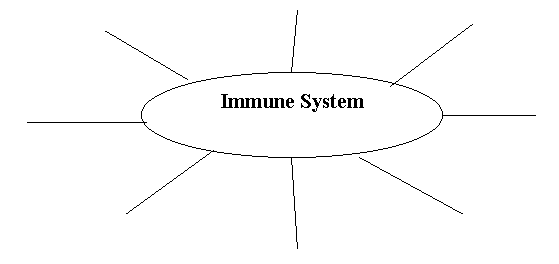
Martine N. Joseph Return to Biology Menu
How can we describe the function and characteristics of the human immune system?
Learning
Objectives:
At the end of this lesson students should be able to:
·
Locate and describe the
functions of all organs of the immune system
·
Explain the three lines
of defense against disease –causing organisms
·
Describe and understand
the specificity of antibodies
·
Compare the defense
mechanism of the immune system to that of a sport team or security system
· Understand the relationship between the immune system and homeostasis i.e. diseases or disorders
Materials
1.
Projector
2.
Laptop or Computer with Microsoft Powerpoint
3.
Disk with PowerPoint demonstration slides (1-7)
Motivation
Ask student if they ever had one of the following infections: Measles; Mumps; Smallpox; Chickenpox; a cold; flu. Discuss why the results are this way. Allow students to come to the conclusions that very few of them if any had the first three infections because of vaccination.
Development
I:
What are some words that come to mind when you see the word 'Immune System'?
Prompt
students to recall definition of system and to use prior knowledge to come to
the definition of 'immune'.
Have
a volunteer write students answers to complete this web

Made of highly specialized cells and a circulatory system consisting of lymphatic nodes and lymphatic vessels.
(Describe
the types of white blood cells, their origin and functions)
Organs of the immune system are made of lymphoid tissues hence the name lymphoid organs. These organs are positioned throughout the body.
Demonstration: Slide II "Organs of the
Immune System"
Demonstration: Slide III “Lymphatic Vessels &
Lymph Nodes”
The
lymphatic vessels and lymphatic nodes are the parts of the special circulatory
system that carries lymph. Lymph nodes dot the network of lymphatic vessels and
provide a meeting ground for the immune system cells (White blood cells chiefly
lymphocytes)
III:
What are of some of the substances or invaders that are targeted by the immune
system?
This slide shows a picture of: Streptococci (Bacteria), mold (Fungi), schistosomiasis (Parasite), and Herpes (Virus).
A. 1st line of defense: Involves several kinds of physical and
chemical barriers.
Elicit: Sweat,
Tears, Saliva, Mucus (chemical barriers)
Elicit: Skin, membrane lining body passages (physical barriers)
B. 2nd line of defense: The Inflammatory Response
Elicit: Swelling, redness, warmth, and pain in the area of an infection. An increased blood flow attracts White Blood Cells i.e. macrophages, phagocytes and neutrophils to infected area.
C. 3rd line of defense: The Immune response
At this stage the immune system is fully active in recognizing, attacking, destroying and 'remembering' each kind of pathogen or foreign substances that enter the body. This step involves the production of antibodies and specialized cells that bind to and inactivate foreign substances.
The
variety of antibodies is very large. Different antibodies are destined for
different purposes. Some coat the foreign invaders to make them attractive to
the circulating scavenger cells, phagocytes, which will engulf an unwelcome
microbe.
(Describe
briefly the structure and function of antibodies)
Describe the causes and effects of several diseases or disorders on the immune system i.e. Allergies, AIDS and Autoimmune disease. This will help students to understand the role of the immune system in helping the body to maintain a well-balanced health state.
Demonstration:
Slide VI: Disorders of the Immune System: AIDS
When
the immune system is lacking one or more of its components, the result is an
immunodeficiency disorder.
Question:
How can a person develop this disorder?
Elicit:
1). Inherited
2).
Acquired through infection
3).
Produced as an inadvertent side effect of drugs such as those used to treat
cancer or transplant patients.
Demonstration:
Slide VII: Autoimmune disorders
Sometimes
the immune system 's recognition apparatus breaks down. The body begins to
manufacture antibodies and T-cells directed to against the body's own cells and
organs contribute to many diseases known as autoimmune diseases.
Summary & Application
Allow students time to respond to the following critical thinking questions in writing. A class discussion could be followed.
1.
Suppose a person's immune response is operating at a below-normal level.
Suggest several possible causes for this deficiency.
2.
Why do you think a person can come down with a common cold over and over
again without developing immunity to it?
This
lesson plan aligns with learning standards
1,2, 4, 5 and 7. It also applies to the following performance
standards
S2a, S2d, S4c, S7a, and S7e.